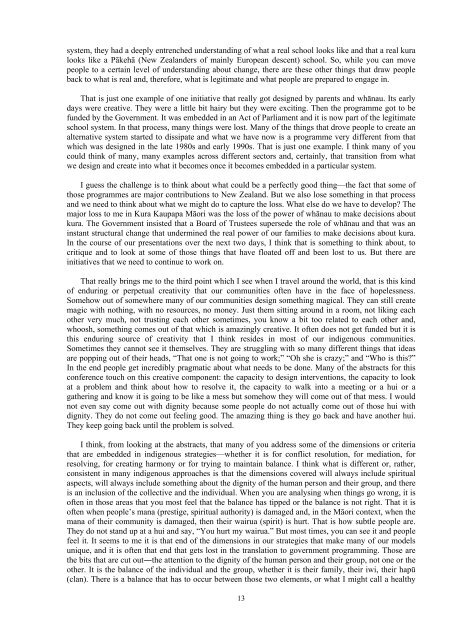traditional knowledge conference 2008 te tatau pounamu
traditional knowledge conference 2008 te tatau pounamu
traditional knowledge conference 2008 te tatau pounamu
You also want an ePaper? Increase the reach of your titles
YUMPU automatically turns print PDFs into web optimized ePapers that Google loves.
sys<strong>te</strong>m, they had a deeply entrenched understanding of what a real school looks like and that a real kuralooks like a Pākehā (New Zealanders of mainly European descent) school. So, while you can movepeople to a certain level of understanding about change, there are these other things that draw peopleback to what is real and, therefore, what is legitima<strong>te</strong> and what people are prepared to engage in.That is just one example of one initiative that really got designed by parents and whānau. Its earlydays were creative. They were a little bit hairy but they were exciting. Then the programme got to befunded by the Government. It was embedded in an Act of Parliament and it is now part of the legitima<strong>te</strong>school sys<strong>te</strong>m. In that process, many things were lost. Many of the things that drove people to crea<strong>te</strong> anal<strong>te</strong>rnative sys<strong>te</strong>m star<strong>te</strong>d to dissipa<strong>te</strong> and what we have now is a programme very different from thatwhich was designed in the la<strong>te</strong> 1980s and early 1990s. That is just one example. I think many of youcould think of many, many examples across different sectors and, certainly, that transition from whatwe design and crea<strong>te</strong> into what it becomes once it becomes embedded in a particular sys<strong>te</strong>m.I guess the challenge is to think about what could be a perfectly good thing—the fact that some ofthose programmes are major contributions to New Zealand. But we also lose something in that processand we need to think about what we might do to capture the loss. What else do we have to develop? Themajor loss to me in Kura Kaupapa Māori was the loss of the power of whānau to make decisions aboutkura. The Government insis<strong>te</strong>d that a Board of Trus<strong>te</strong>es supersede the role of whānau and that was aninstant structural change that undermined the real power of our families to make decisions about kura.In the course of our presentations over the next two days, I think that is something to think about, tocritique and to look at some of those things that have floa<strong>te</strong>d off and been lost to us. But there areinitiatives that we need to continue to work on.That really brings me to the third point which I see when I travel around the world, that is this kindof enduring or perpetual creativity that our communities of<strong>te</strong>n have in the face of hopelessness.Somehow out of somewhere many of our communities design something magical. They can still crea<strong>te</strong>magic with nothing, with no resources, no money. Just them sitting around in a room, not liking eachother very much, not trusting each other sometimes, you know a bit too rela<strong>te</strong>d to each other and,whoosh, something comes out of that which is amazingly creative. It of<strong>te</strong>n does not get funded but it isthis enduring source of creativity that I think resides in most of our indigenous communities.Sometimes they cannot see it themselves. They are struggling with so many different things that ideasare popping out of their heads, “That one is not going to work;” “Oh she is crazy;” and “Who is this?”In the end people get incredibly pragmatic about what needs to be done. Many of the abstracts for this<strong>conference</strong> touch on this creative component: the capacity to design in<strong>te</strong>rventions, the capacity to lookat a problem and think about how to resolve it, the capacity to walk into a meeting or a hui or agathering and know it is going to be like a mess but somehow they will come out of that mess. I wouldnot even say come out with dignity because some people do not actually come out of those hui withdignity. They do not come out feeling good. The amazing thing is they go back and have another hui.They keep going back until the problem is solved.I think, from looking at the abstracts, that many of you address some of the dimensions or cri<strong>te</strong>riathat are embedded in indigenous stra<strong>te</strong>gies—whether it is for conflict resolution, for mediation, forresolving, for creating harmony or for trying to maintain balance. I think what is different or, rather,consis<strong>te</strong>nt in many indigenous approaches is that the dimensions covered will always include spiritualaspects, will always include something about the dignity of the human person and their group, and thereis an inclusion of the collective and the individual. When you are analysing when things go wrong, it isof<strong>te</strong>n in those areas that you most feel that the balance has tipped or the balance is not right. That it isof<strong>te</strong>n when people’s mana (prestige, spiritual authority) is damaged and, in the Māori con<strong>te</strong>xt, when themana of their community is damaged, then their wairua (spirit) is hurt. That is how subtle people are.They do not stand up at a hui and say, “You hurt my wairua.” But most times, you can see it and peoplefeel it. It seems to me it is that end of the dimensions in our stra<strong>te</strong>gies that make many of our modelsunique, and it is of<strong>te</strong>n that end that gets lost in the translation to government programming. Those arethe bits that are cut out―the at<strong>te</strong>ntion to the dignity of the human person and their group, not one or theother. It is the balance of the individual and the group, whether it is their family, their iwi, their hapū(clan). There is a balance that has to occur between those two elements, or what I might call a healthy13
















